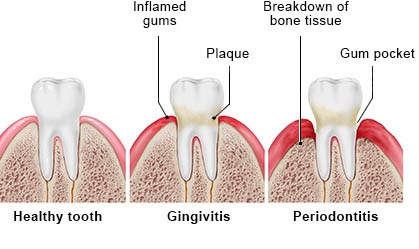
Gingivitis is the first stage of gum disease
Do you know the symptoms of early gum problems, known as gingivitis, or even what it is? Many people know that overly sensitive or deeply stained teeth can be warning signs of dental cavities. Yet people rarely know the early indicators of gingivitis, which is the earliest form of gum disease.
Also called periodontal disease, gum disease involves inflamed or infected gum tissue, which can occur when plaque and tartar accumulate in your mouth. Left untreated, it gets below the gum line and can eventually cause serious issues, such as receding gums and tooth loss.
And since the mouth is the gateway to the body and bloodstream, it could also contribute to overall health problems.
Fortunately, knowing the warning signs can help you avoid progressed gum problems.
Know the signs and symptoms of gingivitis
One way to protect your smile is by simply understanding the early indicators of gum disease. It also helps to know what causes the signs and symptoms.
- bad breath
- soft, swollen, and sensitive gum tissues
- red or darker gums
- bleeding gums when you brush or floss
- tenderness in the gums to the touch
- recession
Most people have transient issues with gum infections. Most don’t even know what the signs of gingivitis are. This is especially true when the issue is more chronic and living with these symptoms seems normal.
Understand the Risk Factors for Gingivitis
While poor oral care is the common reason people develop gingivitis, there are several known risk factors.
These risk factors include:
- Crooked or crowded teeth that collect food particles
- Broken fillings
- Poorly fitting dental appliances
- Tobacco use
- Diabetes
- Pregnancy
- A compromised immune system
- Genetics
- Cancer treatment
- Certain medications, such as steroids, birth control, and medicines for seizures, high blood pressure, or heart conditions
If you have any risk factors, you should be that much more diligent in maintaining excellent oral health and watching for symptoms of gingivitis or full blown periodontal disease.
What causes gingivitis?
Bacteria normally live in your mouth, and each time you eat or drink, you consume more bacteria. They live around and under your tongue, on and between your teeth, and along your gum line. These bacteria feed on the nutrients of your food and beverages, and the product is a sticky film called plaque.
Each time you brush and floss, it removes plaque. If you fail to remove the plaque, it hardens into tartar.
The bacteria, plaque, and tartar can accumulate below the gum line, irritating your gum tissue. This irritation causes the gums to become red and inflamed. Healthy gums should be a light pink color, so if your gums appear deep red or purple, you should pay attention, as they could be infected.
As time goes on and the infection spreads, the gums become tender and swollen and tend to bleed easily. If you notice bleeding when you floss or brush, don’t consider it a reason to stop flossing. Instead, view it as a warning sign that should not be ignored.
Moreover, plaque, tartar, infection, and bleeding can cause chronic bad breath, also known as halitosis.
Do you take steps to control bad breath, such as brushing, flossing, and rinsing with mouthwash but continue to have bad breath? If so, you should see your dentist, as there could be an underlying issue.
 What do you do if you have the symptoms of gingivitis?
What do you do if you have the symptoms of gingivitis?
If you suspect the beginning of gum disease, you should see your dentist for an examination and a professional cleaning of your teeth and gums. After that, an improved hygiene routine with brushing and flossing to remove plaque can help you get rid of the problem.
If the initial infections are not stopped, the infection causes progression to periodontitis, which involves separation between the gums and teeth. As the separation continues, deep pockets form in which more bacteria, plaque, and tartar can accumulate.
While gingivitis and periodontitis are both forms of gum problems, their severity and symptoms are different, as is their treatment. Once the disease process has progressed to periodontitis, you cannot get rid of it, but there are things you can do to control it.
After progressing to periodontitis, treatment requires deep cleaning with scaling and root planing. Follow up periodontal maintenance includes more frequent dental visits to ensure your gums heal properly.
Symptoms of periodontitis can include:
- Loose teeth
- Pain when chewing
- Receding gums
- A change in your bite
- Dental appliances no longer fitting
- Pus between your gums and teeth
- Foul breath that won’t go away
If not treated, gum disease can cause tooth loss. In fact, it is the leading cause of adult tooth loss in American adults. It can also lead to the need for gum surgery.
Protect Your Whole Smile’s Health
The health of your smile is about more than your mouth, as poor oral health can lead to systemic issues such as diabetes, heart disease, and high blood pressure.
The most important way to care for your smile is by combining healthy habits at home with regular checkups and cleanings with your dental professional. The American Dental Association (ADA) recommends visiting your dentist twice a year. Your hygienist will always monitor you for the signs and symptoms of gingivitis.
At home, good oral hygiene includes twice daily brushing, flossing every day, and eating a healthy diet that is low in sugar. For even more protection, you may want to rinse with an antibacterial mouthwash at least once a day.
When you protect your teeth and gums by maintaining good oral health, you are taking steps to prevent gum problems and dental decay.
Do you have symptoms of gingivitis?
If you have symptoms of gum problems, it is time to see your dentist. Early treatment can prevent worsening problems in the future and save you from the need for gum surgery or tooth replacement. Just remember, regular preventive dental care is also essential to keeping your whole smile healthy!
If you are in the greater Chicago area, Dr. James Fondriest can help you with gum problems and its consequences, including dental implants, crowns, and fixed bridges for missing teeth.
Call (847) 234-0517 today to speak to one of our helpful team members and schedule your appointment.

 What do you do if you have the symptoms of gingivitis?
What do you do if you have the symptoms of gingivitis?